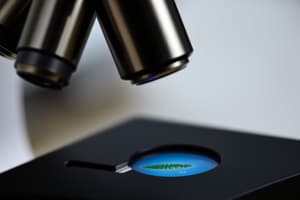Podcast
Questions and Answers
The microscope is an instrument designed to make objects visible that are too difficult or too small to see with the ______ eye.
The microscope is an instrument designed to make objects visible that are too difficult or too small to see with the ______ eye.
unaided
The microscopes commonly used in the biology lab are usually compound binocular or monocular light ______.
The microscopes commonly used in the biology lab are usually compound binocular or monocular light ______.
microscope
The ocular and draw tube rests on the body ______.
The ocular and draw tube rests on the body ______.
tube
Attached to the base of the body tube is the circular revolving ______.
Attached to the base of the body tube is the circular revolving ______.
The microscope is focused by turning two ______.
The microscope is focused by turning two ______.
The fine adjustment knob is used for sharp focus after the object has been brought into view with the coarse adjustment ______.
The fine adjustment knob is used for sharp focus after the object has been brought into view with the coarse adjustment ______.
The ______ barked
The ______ barked
The ______ meowed
The ______ meowed
The platform where you put slides for observation is called the ______
The platform where you put slides for observation is called the ______
The portion of the microscope in contact with the table is the ______
The portion of the microscope in contact with the table is the ______
A short vertical extension on which the arm connects with the base is the ______
A short vertical extension on which the arm connects with the base is the ______
Eyepiece or ocular is the removable cylinder on top of the microscope. It contains one set of lenses, the magnifying power of which is indicated on top of the eyepiece (e.g. 10X or 12.5X). It is called the ______
Eyepiece or ocular is the removable cylinder on top of the microscope. It contains one set of lenses, the magnifying power of which is indicated on top of the eyepiece (e.g. 10X or 12.5X). It is called the ______
Flashcards are hidden until you start studying
Study Notes
Microscope Structure
- The microscope is an instrument designed to make objects visible that are too small to see with the unaided eye.
- It has mechanical and optical parts that work together to magnify objects.
Mechanical Parts
- The draw tube is a hollow cylinder where the eyepiece or ocular is placed.
- The body tube forms the body of the microscope and supports the ocular and draw tube.
- The nosepiece is a circular revolving structure attached to the base of the body tube.
- The dust shield is a metallic structure above the nosepiece that protects the lower lenses.
- The microscope has two focusing knobs: the coarse adjustment knob and the fine adjustment knob.
- The coarse adjustment knob brings the object into view, and the fine adjustment knob is used for sharp focus.
- The illuminator control knob controls the light output of the illuminator.
- The stage is a platform where slides are placed for observation, and it has a circular opening called an aperture.
- The stage has clips or a mechanical device to hold the slide in place.
Carrying the Microscope
- When carrying the microscope, one hand should grasp the arm and the other hand should support the base.
- The base should always be held parallel to the floor.
Optical Parts
- The eyepiece or ocular is a removable cylinder on top of the microscope containing one set of lenses.
- The objective lens gives the initial magnification, with shorter lenses having lower magnification and farther distance from the specimen when focused.
- The microscope may have four objective lenses: scanning lens (4X), low power objective (10X), high power objective (40X), and oil immersion objective (100X).
- The substage condenser is a lens located under the stage aperture, controlling the distance from the stage to condense and focus light on the specimen.
- The iris diaphragm is beneath the condenser, controlling the amount of light passing through the specimen.
Studying That Suits You
Use AI to generate personalized quizzes and flashcards to suit your learning preferences.




